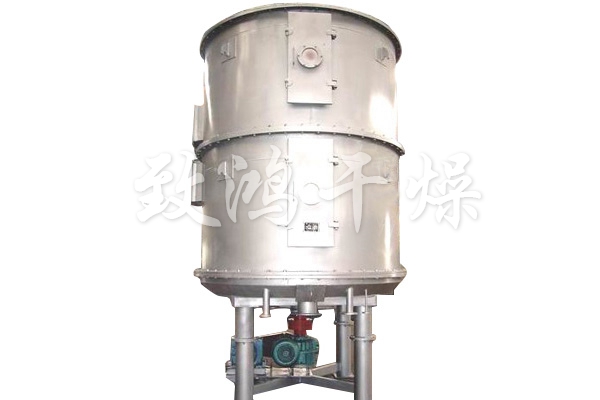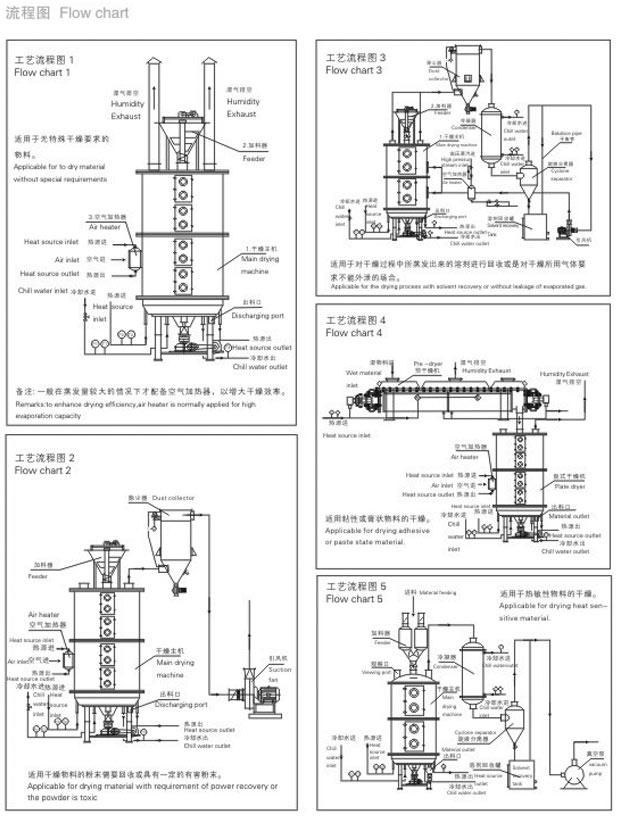Description: The disc continuous dryer is a good conductive continuous drying equipment, and its unique structure and working principle determine its high thermal efficiency
Category: Disc dryer
Detailed explanation:

Overview: The disc continuous dryer is a good conductive continuous drying equipment. Its unique structure and working principle determine its high thermal efficiency, low energy consumption, small footprint, simple configuration, convenient operation and control, and good operating environment. Widely applicable for drying operations in industries such as chemical, pharmaceutical, pesticide, food, feed, and agricultural and sideline product processing. Highly praised in practical use in various industries. It can be divided into three types: atmospheric pressure, sealed, and vacuum; Various specifications such as 1200, 1500, 2200, 3000, etc; A (carbon steel) B (stainless steel in contact with the material), On the basis of B, C adds three materials (stainless steel for steam pipeline, main shaft and support, stainless steel for cylinder and top cover lining), with a drying area of 4-180m2, a series of hundreds of models of products, and can provide matching auxiliary equipment to meet the needs of users for drying various materials.
The disc continuous dryer is a good conductive continuous drying equipment. Its unique structure and working principle determine its high thermal efficiency, low energy consumption, small footprint, simple configuration, convenient operation and control, and good operating environment. Widely applicable for drying operations in industries such as chemical, pharmaceutical, pesticide, food, feed, and agricultural and sideline product processing. Highly praised in practical use in various industries. It can be divided into three types: atmospheric pressure, sealed, and vacuum; Various specifications such as 1200, 1500, 2200, 3000, etc; A (carbon steel) B (stainless steel in contact with the material), On the basis of B, C adds three materials (stainless steel for steam pipeline, main shaft and support, stainless steel for cylinder and top cover lining), with a drying area of 4-180m2, a series of hundreds of models of products, and can provide matching auxiliary equipment to meet the needs of users for drying various materials.
Features:
(1) Easy regulation and strong applicability
1.By adjusting the thickness of the material layer, spindle speed, number of rake arms, rake blade type and size, the drying process can be achieved.
2.Each layer of drying tray can be filled with hot or cold media to heat or cool the materials. The materials are uniformly heated, and the temperature control is accurate and easy.
3.The residence time of materials can be accurately adjusted.
4.The material has a single flow direction, no backmixing phenomenon, uniform drying, stable quality, and no need for further mixing.
(2) Simple and easy to operate
1.The driving and parking operation of the dryer is very simple.
2.After stopping the feeding, the rake blades that transport the material can quickly empty the material inside the dryer.
3.By using a special large-sized inspection door mirror, the equipment can be thoroughly cleaned and observed inside.
(3) Low energy consumption
1.The material layer is very thin, the spindle speed is low, and the material conveying system requires low power and electricity consumption.
2.Drying through heat conduction has high thermal efficiency and low energy consumption.
(4) Good operating environment, recyclable solvents, and dust emissions meet requirements
1.Atmospheric pressure type: Due to the low airflow velocity inside the equipment and the low humidity distribution in the equipment, it is difficult for dust to float to the top of the equipment. Therefore, the exhaust gas discharged from the top dehumidification outlet contains almost no dust.
2.Closed type: equipped with a solvent recovery device, it can conveniently recover organic solvents in wet gases. The solvent recovery device is simple and has a high recovery rate. For flammable, explosive, toxic, and oxidizable materials, nitrogen can be used as a moisture carrying gas for closed-loop circulation, ensuring safe operation. Especially suitable for drying flammable, explosive, and toxic materials.
3.Vacuum type: a disc dryer operated under vacuum, especially suitable for drying thermosensitive materials.
(5) Easy installation and small footprint
1.The dryer is manufactured as a whole and transported as a whole. It only needs to be lifted and positioned, making installation and positioning very easy.
2.Due to the dry tray layout and vertical installation, even if the drying area is large, the footprint is very small.
Application:
Drying, pyrolysis, calcination, cooling, reaction, sublimation
(1) Organic chemical products
(2) Inorganic chemical products
(3) Medicine and food
(4) Feed and fertilizer
Technical characteristics:
(1)Drying tray
1.Design pressure: generally 0.4MPa, up to 1.6MPa.
2.Operating pressure: generally ≤0.4MPa, up to 1.6MPa.
3.Heating medium: steam, hot water, thermal oil, and drying plate. When the temperature is 100 ℃, hot water is used for heating. When the temperature is between 100 ℃ and 150 ℃, saturated steam or superheated steam with ≤ 0.4MPa is used for heating. When the temperature is between 150 ℃ and 320 ℃, thermal oil is used for heating.
(2)Material conveying system
1.Spindle speed: 1-10 RPM, electromagnetic or variable frequency stepless speed regulation.
2.Rake arm: There are 2-8 rake arms fixed on the main shaft on each layer of drying plate.
3.Rake blade: Twisted onto the rake arm, it can float up and down with the disc surface to maintain contact, and there are various forms.
4.Rolling: For materials that are prone to clumping and require crushing, adding rolling at appropriate positions can enhance heat transfer and drying processes.
(3)housing
There are three types: atmospheric pressure, sealed, and vacuum
1.Atmospheric pressure type: cylindrical or octagonal prism type, with two types of structures: integral and split. The main pipeline for heating medium inlet and outlet can be inside the shell or outside the shell.
2.Closed type: a cylindrical shell that can withstand an internal pressure of 5Kpa. The main pipes for heating medium inlet and outlet can be inside the shell or outside the shell.
3.Vacuum type: cylindrical shell with a design pressure of -0.096Mpa, and the main pipeline for heating medium inlet and outlet is inside the shell.
(4) Air heater
It is generally used when configuring an induced draft fan to prevent humid ambient air from entering the main unit and affecting the drying effect.
Principle:
Wet materials are continuously added from the feeder to the upper layer drying plate of the dryer, and the rake arm with rake blades rotates to continuously flip the materials. The material flows through the surface of the drying plate along an exponential spiral, and the material on the small drying plate is transferred to the outer edge. The material on the large drying plate moves inward and falls into the next layer of small drying plate from the middle feeding port. The large and small drying plates are arranged alternately up and down, allowing materials to continuously flow through the entire dryer. The hollow drying plate is filled with heating medium, which includes saturated steam, hot water, and thermal oil. The heating medium enters from one end of the drying plate and exits from the other end. The dried material falls from the last layer of the drying plate to the bottom layer of the shell, and is then transported by the rake blades to the discharge port for discharge. Wet steam escapes from the material and is discharged through the dehumidification port located on the top cover. The wet steam of the vacuum disc dryer is extracted by the vacuum pump port located on the top cover. The dry materials discharged from the bottom layer can be directly packaged. By adding auxiliary machines such as finned heaters, solvent recovery condensers, bag filters, dry material mixing mechanisms, and induced draft fans, the drying production capacity can be improved. Drying paste like and heat sensitive materials can easily recover solvents and perform pyrolysis and reaction operations.
Technical parameter table:
| Specifications | External diameter(mm) | Height(mm) | Dry area (m2) | Power(KW) | Specifications | External diameter(mm) | Height(mm) | Dry area (m2) | Power (KW) |
| 1200/4 | 1850 | 2608 | 3.3 | 1.1 | 2200/18 | 2900 | 5782 | 55.4 | 5.5 |
| 1200/6 | 3028 | 4.9 | 2200/20 | 6202 | 61.6 | ||||
| 1200/8 | 3448 | 6.6 | 1.5 | 2200/22 | 6622 | 67.7 | 7.5 | ||
| 1200/10 | 3868 | 8.2 | 2200/24 | 7042 | 73.9 | ||||
| 1200/12 | 4288 | 9.9 | 2200/26 | 7462 | 80.0 | ||||
| 1500/6 | 2100 | 3022 | 8.0 | 2.2 | 3000/8 | 3800 | 4050 | 48 | 11 |
| 1500/8 | 3442 | 10.7 | 3000/10 | 4650 | 60 | ||||
| 1500/10 | 3862 | 13.4 | 3000/12 | 5250 | 72 | ||||
| 1500/12 | 4282 | 16.1 | 3.0 | 3000/14 | 5850 | 84 | |||
| 1500/14 | 4702 | 18.8 | 3000/16 | 6450 | 96 | ||||
| 1500/16 | 5122 | 21.5 | 3000/18 | 7050 | 108 | 13 | |||
| 2200/6 | 2900 | 3262 | 18.5 | 3.0 | 3000/20 | 7650 | 120 | ||
| 2200/8 | 3682 | 24.6 | 3000/22 | 8250 | 132 | ||||
| 2200/10 | 4102 | 30.8 | 3000/24 | 8850 | 144 | ||||
| 2200/12 | 4522 | 36.9 | 4.0 | 3000/26 | 9450 | 156 | 15 | ||
| 2200/14 | 4942 | 43.1 | 3000/28 | 10050 | 168 | ||||
| 2200/16 | 5362 | 49.3 | 5.5 | 3000/30 | 10650 | 180 |
Note: Some parameters may be adjusted according to different materials during design, and the design shall prevail


Changzhou Zhihong Drying Technology Co., Ltd. is located in the economically developed center of the Yangtze River Delta, Zhenglu Town, Changzhou City. It borders Shanghai to the east and Nanjing to the west, and is situated at the intersection of Hengshan on the Shanghai Nanjing Expressway. It is more than ten miles away from Changzhou Airport and train station, and the transportation is very convenient. The company is a designated production enterprise in the pharmaceutical equipment industry, chemical equipment industry, and food machinery drying equipment industry in China. The company has 60 categories and more than 280 specifications of products, with an annual output of 500 sets of drying, granulation, mixing, crushing, concentration, and extraction equipment, and its products meet GMP requirements.
The company's main products include pharmaceutical machinery, chemical machinery, food machinery, pigment drying machinery, and other products. The products have now covered various markets across the country and are highly favored and praised by domestic users.
How to choose a suitable hot air circula···
24.05.24The integration of drying equipment into···
24.05.24Experts analyze that the Chinese rotary ···
24.05.24Comparison and difference between ultraf···
24.05.24Working principle of purification hot ai···
24.05.24Spray drying is a method of systematic t···
24.05.24Methods of spray drying and comparison o···
24.05.24Internal structure and atomization proce···
24.05.24Granulation function of horizontal spray···
24.05.24Energy efficiency and drying temperature···
24.05.23